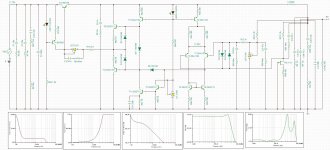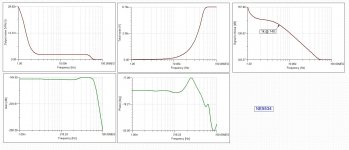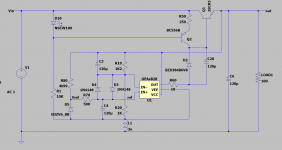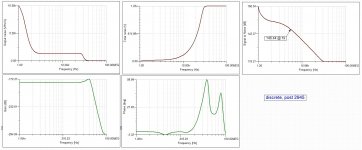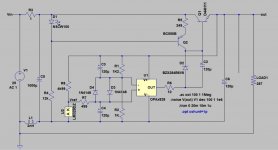Some look very promising, like the OPA828, and one of them surprised me: the LT1611,
Yes, they are promising but don’t let LTSpice set your expectations that high. 🙂
With high OLG opamps and idealized model without parasitic capacitances and inductances, I was getting up to 180 dB PSRR in simulations. Though, real circuit measured results were limited to 120 -130 dB.
Thanks to Rick, it is now confirmed that OPA828 works well (no oscillation) with Jung-Didden regulator. I’m sure that PSRR at low frequency is by 10-15 dB better than measured for original AD825 and noise is excellent as well (probably just 5 nV/rtHz). Another that should be tried is OPA1611. If it doesn’t oscillate, then we have a winner for low noise.
As for the LTSpice simulation, use separate ground line from load resistor to voltage source ground and connect rest of regulator circuit ground with small inductor (3 nH/3mΩ). Add directive ‘.opt cshunt=1p’. That will be enough to get realistic PSRR that would be 130-140 dB max in the LF region.
Denoiser circuits are great but super regulators are incomparably better in transient response department. I measured both. Original Liner Audio article has listening test evaluation results. It was later confirmed that best sounding regulators had better transient response than other.That will be part of the tests when I build a superregulator and try several opamps. And also to compare them with the Denoisators.
Through careful listening and measurements, I’m gradually adopting this as true fact and important power supply property. Different regulators would not change amplifier measured distortion, but they change level of details in sound reproduction and especially soundstage precision, at least for me and my audio equipment.
Mind you, that are very small differences but I find them very satisfying and enjoyable.
Tombo,
Your last comment raises a question I have been asking myself sometimes.
Would it affect simulation results, on a phono preamp I plan to use use these regulators for, if I connect the regulators to them instead of "symbolic" supply?
Your last comment raises a question I have been asking myself sometimes.
Would it affect simulation results, on a phono preamp I plan to use use these regulators for, if I connect the regulators to them instead of "symbolic" supply?
I doubt there would be any significant changes. Probably, you can check by modifying ideal voltage source with internal resistance and AC ripple added to the DC. If that changes don’t reflect on circuit simulation (distortion, noise, square wave response), then there is no point to try with complete PS model added to the phono circuit.
Newer tried discrete opamps, this one is sk99 I sligtly modified and implemented into J.D. 5 volts regulator,, realy don't know if circuit is ok, simulation gives me good result, anybody tell me is this circuit ok? TinaTI sim model in rar archive
Attachments
This is dedicated thread for a Jung-Didden voltage regulator. There are no good reasons to push another designs here.
And, why do you expect that discrete opamp will have any advantage against opamps from TI and Analog devices, that are results of long accumulated design knowledge and some best EEs in this field? Just look at datasheets and application notes.
Correct action would be to open new thread in the Power Supplies section.
And, why do you expect that discrete opamp will have any advantage against opamps from TI and Analog devices, that are results of long accumulated design knowledge and some best EEs in this field? Just look at datasheets and application notes.
Correct action would be to open new thread in the Power Supplies section.
But circuit above is J.D. but with discrete opamp, are we speaking here about opamps? If so, circuit above is one of options, right? Another good opamp for J.D. is SA5534 , good simulation results was similar to post above, real measurement confirmed SA5534 very good for j.d. take a look at post 2871
Last edited:
OK then. In search for better performance, everything is welcome. But, will it perform better?But circuit above is J.D. but with discrete opamp, are we speaking here about opamps? If so, circuit above is one of options, right?
I don't realy know, just want opinions, never tried any discree opamp. I can confirm what tombo56 say about sound details using J.D. regulator, that paid my attention to this type of regulator. From the first build I noticed diference in sound firstly in digital amplifier sound and later I want it on all my audio equipment. Regulators from op simply deserve all attention.
As you are on the improvement task, I'll try to be constructive. 🙂
There is one potential point for an easy PSRR improvement. Replacing R2/R9 with cheap and simple Current Regulator Diode, improves CCS PSRR by 30 dB.
https://www.diyaudio.com/community/threads/improving-simple-ccs-psrr-by-30-db.376744/
This will not translate directly to regulator PSRR. Maybe even nothing at all or it could bring some improvement. You will get nice PSRR boost in LTSpice simulation, but real circuit has other limitations than CCS performance. It’s worth to try and measure.
There is one potential point for an easy PSRR improvement. Replacing R2/R9 with cheap and simple Current Regulator Diode, improves CCS PSRR by 30 dB.
https://www.diyaudio.com/community/threads/improving-simple-ccs-psrr-by-30-db.376744/
This will not translate directly to regulator PSRR. Maybe even nothing at all or it could bring some improvement. You will get nice PSRR boost in LTSpice simulation, but real circuit has other limitations than CCS performance. It’s worth to try and measure.
OK, I did what you recommended with the ground arrangement and adding that .opt directive using OPA828.As for the LTSpice simulation, use separate ground line from load resistor to voltage source ground and connect rest of regulator circuit ground with small inductor (3 nH/3mΩ). Add directive ‘.opt cshunt=1p’. That will be enough to get realistic PSRR that would be 130-140 dB max in the LF region.
1) With the directive it doesn't run. Or if it does it seems to take ages to.
2) With that inductor and without the .opt it does run. But psrr became -56dB between 100Hz-20KHz. The real pssr shouldn't be that bad, I believe. I'm not sure how to change the values to get to something more realistic in psrr.
How much resistance and AC ripple should I add to the voltage source to add to the DC?
About your comments, I did read those listening evaluations at the end of Walton's comparison. It's interesting to see that the Burson regulator, that behaved rather poorly in all measurement areas, came second for listening qualities, right after Jung/Didden and before Perander's. That surprised Walton's too.
For the last year and a half, I have been working together with Mr. Walt Jung on improving the existing regulator. For now, everything is shrouded in secrecy until Walt makes his announcements. The basis of the regulator remains the same, but it is no longer simple, now it has 9 bipolar transistors, 4 depletion mosfets and for the low-noise version a bunch of green LEDs (and we don't use LM329 anymore 😉 )
I tested these regulators with a lot of op amps and the most important ones to mention are OPA1641, ADA4610 and for the 5V version ADA4897, LT6202 or again OPA1641 but in that case with a 1V reference. I didn't test OPA1611 because OPA1641 is jfet op amp and jfet op amp work better in this regulator (same applies to old version), OPA1611 can be considered for 5V version but I think ADA4897 is superior there.
The performance is much better (LTspice shows an improvement of more than 40dB) and the new regulator has been tested up to a current of 5A with a voltage drop of only 3V on the regulator itself which makes it ideal for amplifiers in the A class.
I would mention Walt's forgotten gem, the shunt regulator, which in my opinion is better than the serial one, especially for digital circuits with a lot of HF noise.
I tested these regulators with a lot of op amps and the most important ones to mention are OPA1641, ADA4610 and for the 5V version ADA4897, LT6202 or again OPA1641 but in that case with a 1V reference. I didn't test OPA1611 because OPA1641 is jfet op amp and jfet op amp work better in this regulator (same applies to old version), OPA1611 can be considered for 5V version but I think ADA4897 is superior there.
The performance is much better (LTspice shows an improvement of more than 40dB) and the new regulator has been tested up to a current of 5A with a voltage drop of only 3V on the regulator itself which makes it ideal for amplifiers in the A class.
I would mention Walt's forgotten gem, the shunt regulator, which in my opinion is better than the serial one, especially for digital circuits with a lot of HF noise.
I have tried many opamps in simulation no one gives smooth and linear results than NE5534, right now I have simulated OPA1641 for the first time, its good results but stil NE5534 is smooth and the best? Please see simulation grafs
Attachments
Maybe NE5534 is better in simulation but not in real world, let's say AD825 is much better and even better than AD825 are OPA1641 or ADA4610 and they are all jfet op amps.
And why jfet?
And why jfet?
Something is not right. Did you arrange grounds like at attached picture? I’m getting 125 dB PSRR.2) With that inductor and without the .opt it does run. But psrr became -56dB between 100Hz-20KHz. The real pssr shouldn't be that bad, I believe. I'm not sure how to change the values to get to something more realistic in psrr.
Just try some extreme opposite values to check, like 1 mΩ/1Ω and 0V/1 V AC ripple.How much resistance and AC ripple should I add to the voltage source to add to the DC?
Attachments
New regulator is great news, but I wouldn’t consider regulator with 3V voltage drop @5A as ideal for A class amplifiers. I’m happy with 0.3V drop @ 10A as ideal for an A class.The performance is much better (LTspice shows an improvement of more than 40dB) and the new regulator has been tested up to a current of 5A with a voltage drop of only 3V on the regulator itself which makes it ideal for amplifiers in the A class.
Datasheet of the NE5534 says that opamp is suitable for servo error amplifiers but OPA1641 more for audio purpose, does it have sense and does simulation have sense at all? I rely have no idea why simulation give better result on ne5534 than opa, thats strange, even discrete version give better result than booth, strange.Maybe NE5534 is better in simulation but not in real world, let's say AD825 is much better and even better than AD825 are OPA1641 or ADA4610 and they are all jfet op amps.
And why jfet?
Attachments
Something is not right. Did you arrange grounds like at attached picture? I’m getting 125 dB PSRR.
Just try some extreme opposite values to check, like 1 mΩ/1Ω and 0V/1 V AC ripple.
Attachments
What is the reson for using a voltage reference instead of a zener at the opamp output?anybody tell me is this circuit ok?
This is a fantastic news! Can you please tell us if a circuit board will be available for purchasing? And also the approximate expected timeframe of the announcement (next month, 3 months from now, etc.). Finally, what is the best way to receive this announcement (e.g. an email list or check this thread or check some other website, etc.).For the last year and a half, I have been working together with Mr. Walt Jung on improving the existing regulator. For now, everything is shrouded in secrecy until Walt makes his announcements.
Also thank you for your insight on the best opamps for the Superregulator. What is your opinion on AD797 as opposed to those you have mentioned? And also on OPA828 with the 8V supply (like +/-4V) in a Superregulator with the 13V input and either 8V or 5V output and 0.3A load? Thanks again!
- Home
- The diyAudio Store
- Super Regulator
